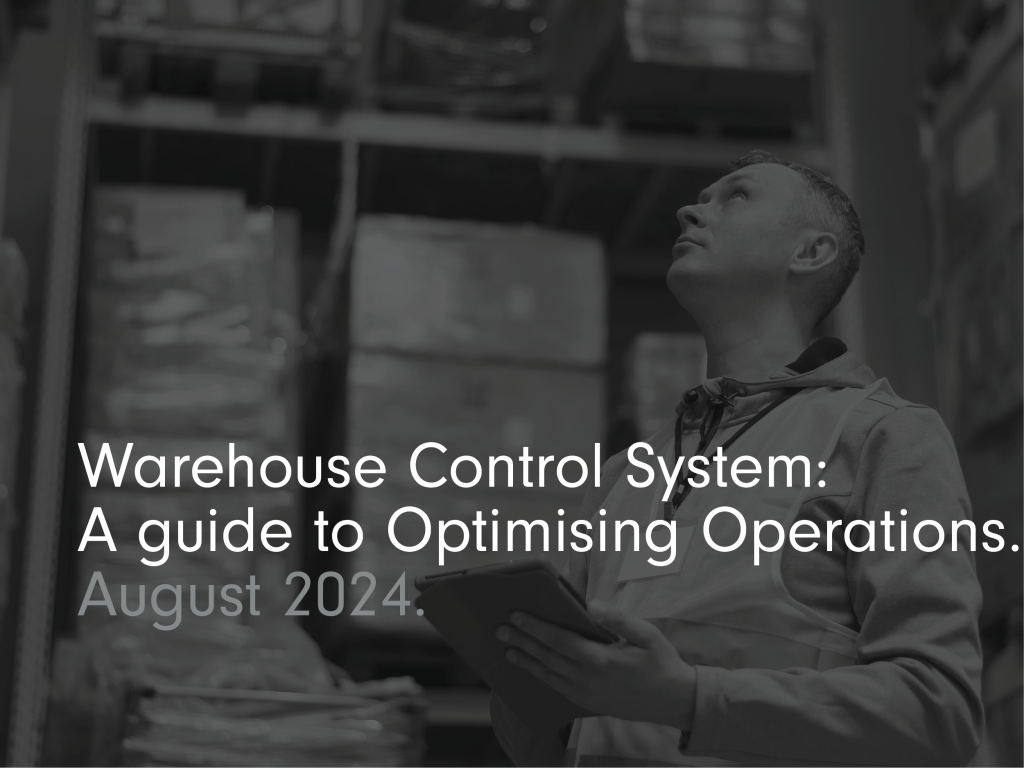Warehouse Control System: A Guide to Optimising Operations

Efficient warehouse management is the backbone of modern logistics and supply chain operations. Technology is evolving quickly, and consumers want more. This makes it important for logistics managers and warehouse operators to improve processes and work more efficiently.
One powerful tool in achieving this is the Warehouse Control System (WCS). This post aims to explore the intricacies of WCS, its role in warehouse operations, and how it can benefit your business.
What is a Warehouse Control System (WCS)?
A Warehouse Control System (WCS) is a smart software that helps run and manage daily activities in a warehouse. It differs from a Warehouse Management System (WMS), which focuses on tracking inventory and warehouse operations.
A WCS actively controls machinery and equipment, like conveyors, sorters, and automated systems, to move and store items. It functions between the WMS and warehouse activities to ensure smooth picking, packing, and shipping of orders.
A WCS’s main features are real-time tracking, smart material routing, and easy integration with warehouse operations. It offers detailed control, enabling operators to manage equipment and workflows with flexibility. A WCS bridges the gap between inventory management and operations. It ensures materials are exactly where they need to be, right when needed.

The Role of WCS in Warehouse Operations
Seamless Integration with Material Flow and Supply Chains
A WCS helps connect the flow of materials and the wider supply chain smoothly. This makes it easier to coordinate different parts of the supply chain, from receiving goods to completing orders. It gives logistics managers a clear overview of their operations, helping them make better decisions and plan strategically.
Enhancing Efficiency in Order Fulfillment and Distribution Centres
Efficiency is key in any warehouse. A WCS is crucial for this. It automates material routing and goods flow, speeding up order processing.
In distribution centres, speed and accuracy matter. A WCS helps pack and ship orders correctly. This boosts customer satisfaction and lowers returns.
Real-Time Monitoring and Efficient Routing in Warehouse Processes
Real-time monitoring is a key part of a WCS. It gives warehouse operators immediate information on process status, allowing quick response to problems. Efficient material routing reduces bottlenecks and boosts productivity. A WCS optimises material paths by analysing data, streamlining operations, and minimising delays.
Benefits of Implementing a WCS
Increased Operational Efficiency and Accuracy
Implementing a WCS leads to significant improvements in operational efficiency and accuracy. Automating many routine tasks in warehouse operations, a WCS cuts down on human error. This automation ensures consistent and accurate process execution, boosting productivity and reducing mistakes.
Improving Inventory Management
A WMS primarily manages inventory, while a WCS controls the movement of goods within the warehouse. This synergy optimises inventory levels, reducing overstocking or stockout risks. A WCS tracks the real-time location and status of inventory. This tracking helps maintain optimal stock levels and improves order fulfillment rates.
Reduction in Labour Costs and Improved Safety
Automating material handling processes with a WCS can lead to substantial reductions in labour costs. By minimising the need for manual intervention, a WCS frees staff to focus on more value-added activities. Automated systems are usually safer than manual ones, lowering the chance of accidents and making warehouses safer.

Understanding the Interaction of WCS with Other Systems
Relationship with Warehouse Execution Systems (WES) and Equipment Controllers
A Warehouse Control System (WCS) works with systems like Warehouse Execution Systems (WES) and equipment controllers. While a WES optimises task execution in the warehouse, a WCS controls the equipment for these tasks. This ensures efficiency in meeting both strategic goals and operational needs.
The Importance of Software Applications in Determining Efficient Operations
A Warehouse Control System (WCS) works well if it has good software. Smart algorithms help it make decisions about moving materials quickly. With the latest software, a WCS improves over time, ensuring efficient warehouse operations that can adapt to new needs.
Future Trends in Warehouse Control Systems
Automation and the use of AI in WCS
Advancements in automation and artificial intelligence (AI) will play a big role in shaping the future of Warehouse Control Systems (WCS). AI-powered WCS can look through lots of data to find patterns and make smart decisions ahead of time. This means warehouses can prepare for changes in demand, use their resources better, and improve how well they operate. The combination of automation and AI will lead the next big wave of innovation in how warehouses are controlled.
Potential Challenges and How to Overcome Them
The benefits of Warehouse Control Systems (WCS) are evident. However, businesses may encounter challenges during implementation. Integrating the WCS with existing systems poses a challenge. Training staff to use the new technology is another hurdle.
Ensuring the system can scale with demand is crucial. Overcoming these challenges demands careful planning. Selecting the right technology partners is key. Investing in ongoing training and support for staff is essential.

Conclusion
A Warehouse Control System (WCS) is key to making today’s warehouses more efficient. It helps manage everything from when goods arrive to when they’re shipped out, by tracking in real time, directing where things should go, and working smoothly with other systems. Using a WCS can lead to many benefits, like making fewer mistakes, better handling of stock, and saving money on labour costs.
Investing in a Warehouse Control System (WCS) is a smart choice for logistics managers and warehouse operators to get ahead and make more money. As technology continues to evolve, the capabilities of WCS will expand, offering even greater opportunities for improvement in warehouse operations.
Frequently Asked Questions.
A Warehouse Control System (WCS) is a software application for real-time warehouse management. It focuses on controlling material handling equipment and processes.
A WMS concentrates on inventory management and warehouse operations. In contrast, a WCS directly controls material handling equipment and real-time warehouse processes.
Benefits include increased operational efficiency and accuracy, optimised inventory management, reduced labour costs, and improved safety.
A WCS often works with Warehouse Execution Systems (WES) and equipment controllers to ensure efficient and coordinated warehouse operations.